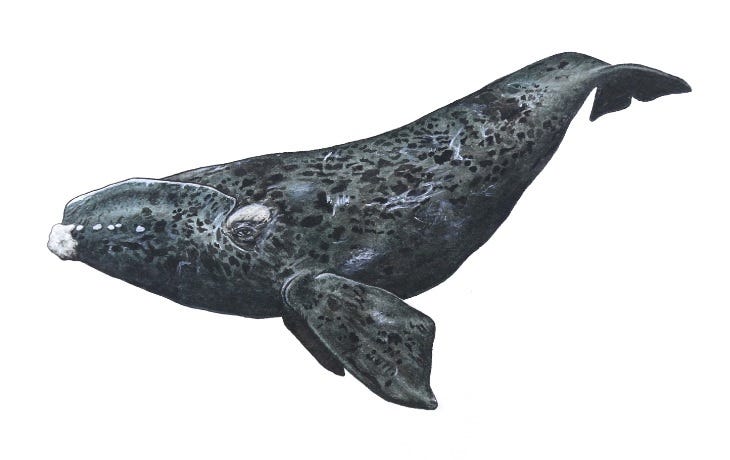Check out Julia Barnes’ extraordinary watercolors of marine creatures—like the right whale she painted, above. The Canadian filmmaker’s documentaries are The Sea of Life and Bright Green Lies.
Hear Hector Aristizabal tell how he transformed his wounds into medicine—and then invite you to do the same.
For two decades, Benedictine nuns in Kansas have taken on Netflix, Amazon and Google. Tiffany Stanley reported for the Associated Press that even when their stocks amount to only $2,000, the nuns propose resolutions at shareholder meetings. For examples, they’ve requested that Chevon assess its human rights policies, and that Amazon publish its lobbying expenditures.
Erik Fernholm and colleagues have named inner development goals (IDGs) to develop skills for sustainable development. I don’t follow Fernholm’s belief that “we have the technology” to create a sustainable society (unless we call drastic reduction of production and consumption “technology”); but I welcome the “scaffolding” he provides for people to discuss the relationship between our inner lives and global happenings. Internationally, 700 hubs now discuss these themes. There’s also a summit October 16-18 in Stockholm and online. In Nate Hagens’ interview, Fernholm talks about cultivating change from the inside out and billionaires who realize that the money they’ve acquired comes from luck…and they are obliged to return the money to the public.
Amerissa Giannouli lists people who educate for degrowth.
Cultural Survival posted 15 Calls to Action on Indigenous Peoples Day.
South Africa’s Pumla Gobodo-Madikizela won the 2024 Templeton Prize for exploring ways to nurture deep empathy between victims and perpetrators of conflict and avoid “the passing on of grievance and a sense of victimhood from one generation to the next.”
Andrew Nikiforuk calls last July’s tech meltdown a wake-up call. “If you hate being hostage to opaque digital systems owned by a few,” he says, “join the great unplugging.”
In the NY Post, Brooke Kato reports that some social media influencers now boast that they’re “underconsuming”—and they’re not influenced by corporate ads.
Check out John-Scott Legg’s conversation with Joe Allen, on the human-machine interface.
Read why novelist Ann Patchett regrets signing up for email. N.B. to access The NY Times online, go through your public library’s hub.
In Northern Arizona, The Hualapai Tribe filed a legal challenge to planned lithium mining that would impact a sacred spring. In late August a judge ordered a temporary halt to preliminary drilling.
Schools, Kids & Social Media
Parents Learn to Play Too: A Parent’s Guide to the Early Years by Susie Beghin
As screen time seeps into the lives of younger and younger kids, parents struggle to set limits, handle meltdowns and safeguard sleep. See Delaney Ruston, MD’s Screenagers: Elementary School Edition. Social Studies, Lauren Greenfield’s documentary series chronicles the lives of teenagers whose childhoods were shaped by social media.
A Danish school has returned to using books and pens.
Some NYC teens have rejected cellphones and social media.
Check out The Human Nature School in northern Michigan.
Educational offerings
In The Regeneration Handbook: System-changing strategies, Don Hall reports on regional food hubs, local currencies (to keep wealth circulating locally, rather than going to corporate headquarters), local investment networks and community land trusts.
While Harvard professor of psychiatry Judith G. Edersheim says the effect of giving children a smartphone is like putting them in a 24/7 casino and serving them chocolate-flavored booze, Ted Gioia names 8 Ways of Connecting Your WiFi Can't Deliver: with nature; with family, friends, neighbors and colleagues; with history and tradition; civil engagement; acting charitably and giving support; connecting spiritually, beyond the materialist realm; making art; and via love, forgiveness, fidelity, trust, empathy and kindness—the things computers can’t provide.
To learn about the waste and destruction of one industrial wind turbine project in upstate New York, watch Green Madness. One turbine starts with 900 tons of steel, 1000 pounds of copper, 2500 pounds of plastic and 2500 tons of cement. Not exactly “clean” or “renewable.”
Elisabeth Robson’s two-part video, What is Offshore Wind Energy? Part 1 explains how turbines are manufactured and how they work. Part 2 reports on their impacts on wildlife.
How to reduce radio wave exposure in a Toyota.
Sarah Aminoff reports that Apple watches do not belong in water: their forever chemicals (PFAs) pollute. In salt water (i.e., ocean water or a mineral springs hottub), electronics can fry. Then, lithium batteries expand when they fail—which can shatter the watch’s screen.
Dr. Joel Moskowitz (UC/Berkeley School of Public Health) presented “Health Hazards of Wireless Technologies: What do we know now?” at the Collaborative for Health & Environment, September 25, 2024. Dr. Moskowitz reported on recent studies and addressed the World Health Organization's efforts to assure the public that wireless radiation is safe…based on flawed WHO-commissioned research. The preponderance of scientific evidence shows adverse biological and health effects from the radiofrequency (RF) radiation generated by wireless technology. Major studies document that RF exposure increases lab animals’ incidence of certain tumors; and epidemiological studies find increased risk of certain tumors associated with long-term mobile phone use.
Data collection in modern cars can lead to dramatic rises in insurance premiums since automakers share drivers’ behavior (i.e., hard braking) with insurance companies. Before buying a car, learn how to opt out of data collection. MSN
To locate the data centers near you, Search Data Centers: Colocation, Bare Metal, Cloud. To access the site, check off the options for cookies at the homepage’s bottom. Then, for example, see the data centers in Massachusetts.
Here’s a new book: AI Snake Oil: What Artificial Intelligence Can Do, What It Can’t, and How to Tell the Difference by Arvind Narayanan & Sayash Kapoor, Princeton Press.
and in case you missed my last Substack: A recipe for respecting nature and technology’s limits—and another for exploiting them.



